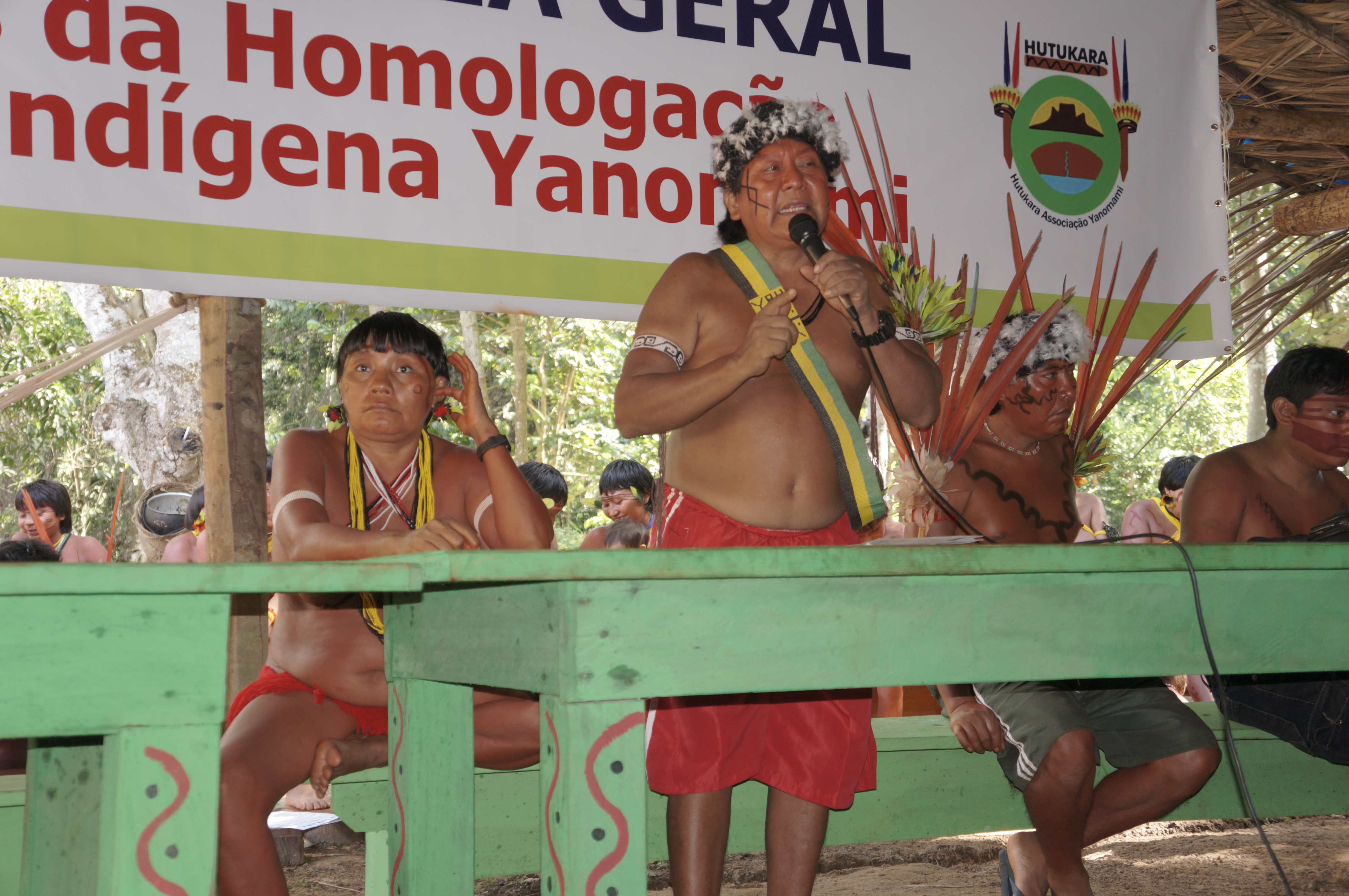The Hutukara Associação Yanomami (HAY), or Hutukara Yanomami Association, is a nonprofit organization that unites the Yanomami Indigenous Territory’s inhabitants – or Terra Indígena Yanomami (TIY), in Portuguese. The Yanomami are an Indigenous group of Northern Amazonia, currently with a population of around 30,000 people, living in the interfluvial region between the Orinoco and the Amazon river basins in Brazil and Venezuela. Created in 2004, HAY is one of the most active Indigenous organizations in Brazil, exercising the role of political articulation and coordinating projects aimed at territorial protection (especially against the invasion of illegal miners), ethno-environmental management, healthcare, training, research, and other initiatives, working with national and international partners involving both public and civil organizations.
HAY’s creation was declared in 2004 at an assembly of the Yanomami in the community of Watorikɨ, in the state of Amazonas, Brazil, where one of its leaders lives, the intellectual and shaman Davi Kopenawa (c. 1956-). Assemblies gathering Yanomami leaders have taken place since the 1990s in the Yanomami Indigenous Territory, which was demarcated and homologated by the Brazilian government in 1992, in an area of 96,650 km2. Today the General Assembly is convoked every four years. Since its foundation, Davi Kopenawa has been re-elected as the Association’s president, and his son, Dario Vitório Kopenawa, was recently chosen in 2022 to occupy the post of vice-president. HAY’s Statute defines the posts and responsibilities of the directorship and the sector coordinators.
 © Fiona Watson / Survival International. Davi Kopenawa at the 7th Hutukara Assembly, 2012. Reproduced with permission.
© Fiona Watson / Survival International. Davi Kopenawa at the 7th Hutukara Assembly, 2012. Reproduced with permission.
According to Kopenawa, the name Hutukara was chosen for the Association by the xapuri thëpë, the Yanomami shamans. The word hutukara acquires diverse meanings in different contexts based on Yanomami cosmology. Hutukara is the sky that fell in the primordial times, constituting the plane on which we now live, that of urihi, the earth-forest, a living being populated by visible and invisible beings. It is, therefore, the shamanic name for the current earth that evokes primordial spacetime. The xapuri thëpë may also use the term hutukara to refer to the current sky, also known as hutumosi. Translated into a philosophical and ecological language, the term hutukara is associated with what non-Indigenous people call the universe, world, or planet Earth. The attribution of this name explains the Association’s role as a defender of the earth-forest and its peoples.
The creation of these Yanomami associations, beginning with the Yanomami Association of the Cauaburis River and Tributaries (AYRCA), founded in 1998, can be situated in the context of the changes in the profile of the Indigenous movement following the promulgation of the 1988 Federal Constitution of Brazil. The rights acknowledged in the new Constitution led to the proliferation of organizations, as well as the strengthening of NGOs working on Indigenous matters and/or environmental issues, establishing cooperative networks that helped prepare Indigenous leaders to deal with the world of government policies and projects. Among important references for the process that culminated in the foundation of HAY, Davi Kopenawa highlights in particular, the political activities of Ailton Krenak (1953-) and Álvaro Tukano (1953-), Indigenous leaders in Brazil, who coordinated the Union of Indigenous Nations (UNI) in the 1980s, as well as the leaders of the Roraima Indigenous Council (CIR), then called the Indigenous Council of the Roraima Territory (CINTERR) and some indigenist organizations – Indigenism refers to Latin American state policies, government sectors, and civil society organizations working with Indigenous affairs. Among the latter, we can pick out the Commission for the Creation of the Yanomami Park (CCPY, later renamed the Pro-Yanomami Commission), an entity founded in 1978 by the Brazilian photographer Claudia Andujar (1931-), the French anthropologist Bruce Albert (1952-) and the missionary Carlo Zacquini (1937-). Its aims were the creation of a Yanomami Indigenous Park, the protection of the territory, and the defense of the indigenous communities. With the closure of CCPY, some of its activities were taken over by the nonprofit organization Instituto Socioambiental (ISA), today an important partner of HAY.
Consolidating Indigenous activism in confronting the so-called ‘new gold rush’ and the criminal organizations associated with it, Hutukara aims to represent all the Yanomami and Ye’kwana people who live in the Yanomami Indigenous Territory (TIY), reflecting the linguistic, cultural, historical, and self-identificatory diversity that singularizes the different regional subgroups. Following the creation of HAY, other associations uniting the inhabitants of the TIY have emerged in Roraima and Amazonas states, including the Wanasseduume Ye’kwana Association, Kurikama, Kumirayoma, Taner, Hwenama, and, more recently, Urihi and Ypasali.
The existence of diverse Indigenous organizations associated with particular regions, the range of different issues that these confront, and the challenge of interacting with a system of political representation alien to their own modes of organization prompted HAY’s directors to undertake a reflection on their own representativeness and functions. One of the outcomes of this reflection was the effort to articulate regional leaders and organizations from the TIY at the Leadership Forum: a space of debates and decision-making, formally recognized since 2015, in which HAY plays a proactive role.
Based in the city of Boa Vista, in the state of Roraima, the Association maintains close connections with the communities dispersed through the forests of the TIY, receiving their demands and supplying information and responses through a network of radio receivers, telephone communications, letters, and social media, or through meetings. The Association acts in the defense of Indigenous rights, mobilizing leaders and helping them mediate with non-Indigenous society and public bodies, as well as making formal denunciations through official letters and documents. Its mediating role includes monitoring the implementation of public policies targeted at Indigenous peoples, especially those relating to healthcare, education, and cultural valorization, and stimulating projects designed to improve life in the communities. HAY also organizes leadership forums, ordinary and extraordinary general assemblies, and regional meetings that bring together Yanomami (and sometimes spokespersons for other peoples), representatives of state bodies, and partner organizations in order to discuss the population’s problems and demands. Workshops are also organized to deal with specific issues, such as the elaboration of the Territorial and Environmental Management Plan for the TIY and the Consultation Protocol (between 2015 and 2019), or targeted at particular sectors of Yanomami society, such as women and young people.
HAY liaises with other elements from the Indigenous movement and with Indigenous organizations (Roraima Indigenous Council, Articulation of the Indigenous Peoples of Brazil, Coordination of Indigenous Organizations of Brazilian Amazonia, and Alternative Cooperation Network, among others) in pursuit of common political objectives, enabling the participation of the Yanomami in protests and encounters with representatives of public bodies in Boa Vista, Brasília, and other localities. The Association also establishes partnerships with governmental and non-governmental institutions and with funding organizations for the implementation of projects focused on territorial protection, the training of teachers, indigenous health agents, communicators, and others, income generation, and the valorization of languages and cultures. In this latter context, we can highlight the autoethnographic and intercultural research projects, resulting in didactic and paradidactic publications, support for artists and the production of Yanomami filmmakers, and participation in cultural and artistic events at national and international universities and cultural centers.
Hutukara seeks to maintain the always unstable balance between the management practices and autonomous tendencies of the diverse groups that refuse control and centralization. The way in which this organization operates, as a ‘tool borrowed’ from the ‘white world,’ entails meeting moral and social obligations that involve kin and allies, whose demands may well only be partially met.
How to cite:
Dalmonego, Corrado. 2024. Hutukara Yanomami Association. Translated by David Rodgers. In: Enciclopédia de Antropologia. São Paulo: Universidade de São Paulo, Departamento de Antropologia. https://ea.fflch.usp.br/en/institutions/hutukara-yanomami-association
ISSN: 2676-038X (online)
[ PDF version ]
Corrado Dalmonego
Translated by David Rodgers
Website: https://hutukarayanomami.org/
ALBERT, Bruce, “O ouro canibal e a queda do céu: uma crítica xamânica da economia política da natureza”, Série Antropologia, n. 174, Brasília, UNB, 1995, p. 1-33
ALBERT, Bruce, “Associações indígenas e desenvolvimento sustentável na Amazônia Brasileira” In: Carlos Alberto Ricardo (org.), Povos Indígenas no Brasil: 1996/2000, São Paulo, Instituto Socioambiental, 2000, p.197-203
ALBERT, Bruce, “Yanomami”, Instituto Socioambiental | Povos Indígenas no Brasil, https://pib.socioambiental.org/en/Povo:Yanomami Acessado em 22/04/2024
ALBERT, Bruce & KOPENAWA, David, Yanomami, l’esprit de la forêt, Paris, Fondation Cartier/ Actes Sud, 2022 [collection Voix de la Terre].
CARVALHO, Maria Auxiliadora Lima de, Os movimentos políticos Yanomami: análises da construção de suas demandas e reivindicações. Dissertação de mestrado. Boa Vista, Universidade Federal de Roraima (Programa de Pós-Graduação em Sociedade e Fronteira), 2015, 162 f.
KELLY, José Antonio, “Notas para uma teoria do ‘virar branco’”, Mana, Rio de Janeiro, v. 11, n. 1, 2005, p. 201-234
KELLY, José Antonio Luciani. “Os Encontros de Saberes: equívocos entre índios e Estado em torno das políticas de saúde indígena na Venezuela”, ILHA, Florianópolis (SC), UFSC, v. 11, n. 2, 2010, p. 265-302
KOPENAWA, Davi, “Në ropë”, Piseagrama Magazine, online version, Read in English section, Belo Horizonte, Dec. 2024 (Ana Maria Machado, Monyque Assis Suzano, Maria Bernadete Morosini, Transl.).
KOPENAWA, Davi & ALBERT, Bruce, La chute du ciel. Paroles d´un chaman yanomami, Plon, Terre humaine, 2010
KOPENAWA, Davi & ALBERT, Bruce, The falling sky: words of a shaman Yanomami, Belknap Press, 2013
LUCIANO, Gersem dos Santos, O Índio Brasileiro: o que você precisa saber sobre os povos indígenas no Brasil de hoje, Brasília, Ministério da Educação, Secretaria de Educação Continuada, Alfabetização e Diversidade; LACED/Museu Nacional, 2006
RAMOS, Alcida Rita; SENRA, Estevão Benfica & WESLEY, Marcos Oliveira (orgs.), Terra indígena Yanomami 30 anos: o futuro é indígena, São Paulo, Instituto Socioambiental, Hutukara Associação Yanomami, 2022
TOTTI, Brisa Catão. Os Yanomami, a Hutukara e os desafios de seu pacto político. Dissertação de mestrado. Florianópolis, Universidade Federal de Santa Catarina (PPGAS), 2013
VIEIRA, Marina A. R. de Mattos & LIMA, Lucas, P. das N. S. (orgs.), Plano de Gestão territorial e Ambiental – Terra Indígena Yanomami, Hutukara Associação Yanomami, 2019

